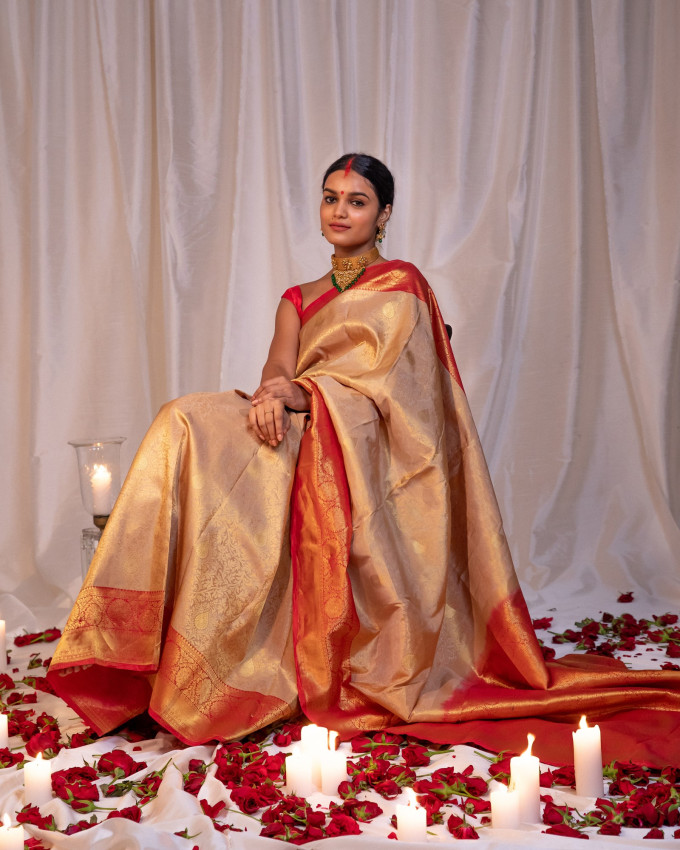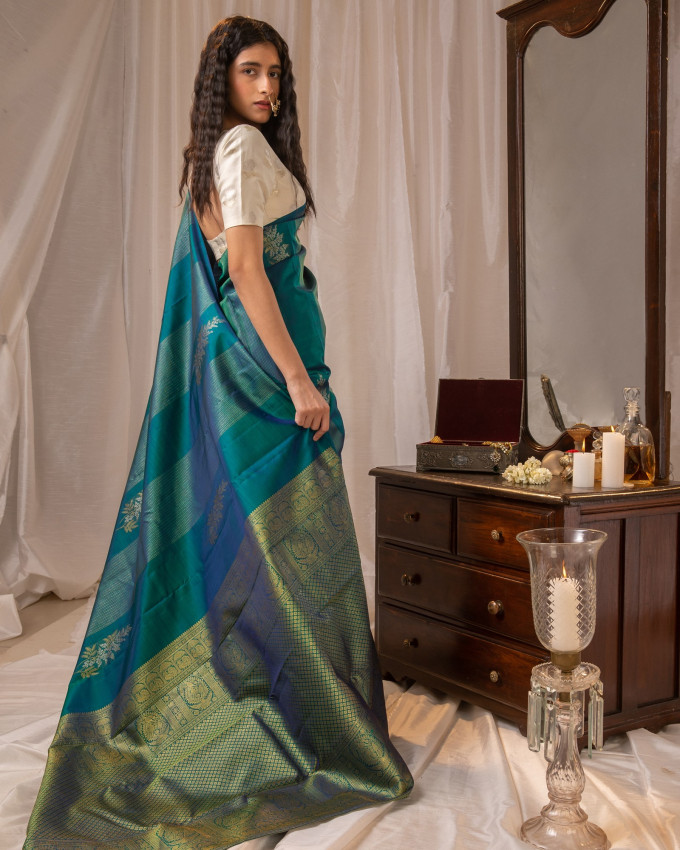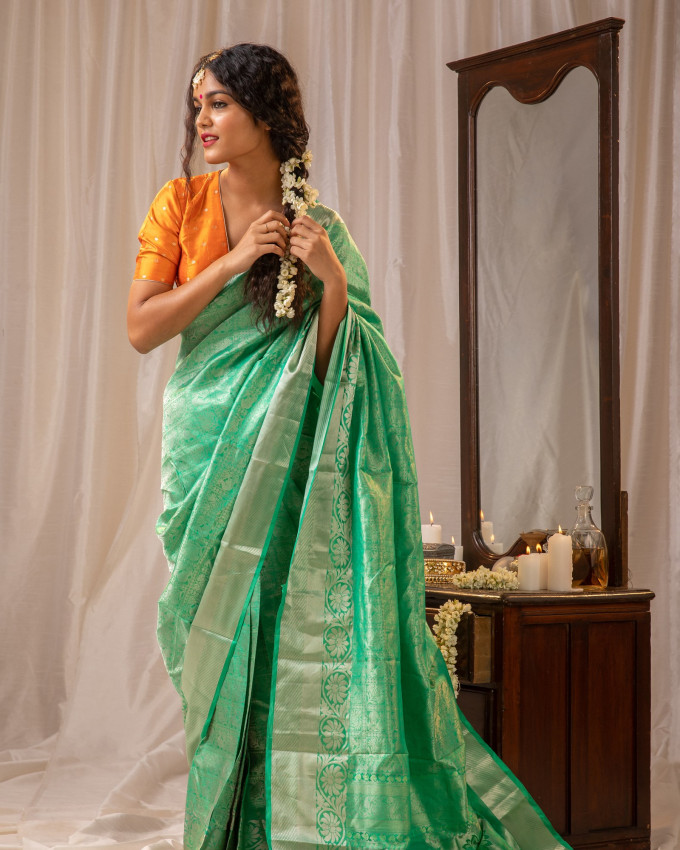How Kanjeevaram saris are redefining heritage for young women
If Athiya Shetty’s wedding saree or Rekha’s fabulous trousseau made your heart skip a beat, know that you weren’t alone. The first thing that comes to anyone’s mind at the mention of a sari is the luxurious Kanjeevaram silk sari, known for its elegance and radiance.
Binal Patel, founder of brand Binal Patel, believes wearing a Kanjeevaram sari for a wedding is a declaration of one’s cultural identity. She said lighter Kanjeevarams, in particular, are perfect for summer weddings, owing to how comfortable they are to wear, and this caters to modern women who refuse to sacrifice comfort for elegance. “Lighter Kanjeevarams are luxurious and handcrafted too, giving it an heirloom quality at accessible price points,” said Patel.

John Varghese, professor at the School of Fashion, World University of Design, noticed a cultural shift of youngsters embracing Indian culture in unique ways. “Kanjeevaram saris, and silk fabrics creatively repurposed as garments, can be seen at corporate, ceremonial and festive events,” he said.
In the third dispatch of our ongoing series on Indian textiles, we look at the rich legacy of Kanjeevaram saris. Take a deep dive into the origins of this traditional fabric, learn how this heirloom is produced, markers for authenticity, and why it’s gaining such rapid popularity among the modern youth.
Tracing the roots of Kanjeevaram saris
“The Kanjeevaram sari finds its origins, and name, in Tamil Nadu’s Kanchipuram, a temple town famous for silk weaving,” said Patel. “Legend has it that the Kanchi silk weaver behind these saris is a descendant of Sage Markanda — Gods’ master weaver — known to craft exquisite pieces from delicate lotus fibres.”
Originally nine yards in length, Kanjeevaram saris evolved over time into the iconic six-yard versions. The craft of Kanjeevaram sari weaving spans 400 years, and is traditionally practised within temple confines by dedicated artisans, Varghese explained.
“In South Indian weddings, Kanjeevaram silk saris, representing purity, elegance and prosperity, hold a place of honour,” said Varghese. Bharatanatyam dancers, too, embrace these silks saris to enhance grace and grandeur of their performance through its rich textures and vibrant colours.
How are Kanjeevaram saris made?
Patel detailed the making of these saris, step-by-step:
Selection of Silk: The process begins with selecting high-quality mulberry silk, traditionally sourced from farms in Tamil Nadu and Karnataka. This silk is prized for its durability and lustrous texture.
Dyeing: The raw silk threads are dyed using vibrant, natural colours. The dyeing process involves soaking, boiling, and washing the threads multiple times to achieve rich, long-lasting hues.
Spinning: After dyeing, the silk threads are spun to enhance their strength and sheen. The threads are twisted into varying thicknesses and wound onto bobbins, ready for weaving.
Weaving: This intricate process can take days or weeks. Skilled weavers use hand looms to interlace the warp (lengthwise threads) and weft (crosswise threads). Borders and the body of the sari are often woven separately and then joined using the “korvai” technique. Elaborate designs and motifs, often inspired by temple architecture and nature, are woven using zari (gold or silver thread).
Finishing: The sari undergoes trimming to remove excess threads, washing to soften the fabric, and ironing to smooth out wrinkles, giving it a crisp finish.
What gives these saris the unique texture?
“The border, body, and pallu of Kanjeevaram saris are woven simultaneously as three distinct components, directly on the loom, without any attachment or stitching later,” said Varghese.
This technique results in three vibrant and solid colour ground areas—one each for the body, border, and pallu—made possible by combining the Korvai and Petni techniques.
The Korvai technique employs an interlocked weft tapestry technique method to weave distinct borders simultaneously with the body, using three shuttles for this part of the saris.
The Petni technique, on the other hand, involves painstakingly joining contrasting coloured new warp yarns to the existing warp, by hand, creating a distinct “Thalai”, which translates to “head” indicating the pallu, from the “Udal”, which means the “body”.
“In addition to the plain weave using silk yarns, further patterning is achieved using metallic yarns through supplementary weft techniques like brocading or using jacquard mechanisms,” said Varghese.
The different kinds of Kanjeevaram saris
The Classic
 Classic kanjeevaram (Source: Binal Patel)
Classic kanjeevaram (Source: Binal Patel)
This quintessential Kanjeevaram sari is woven using traditional techniques. Two weavers work simultaneously, interlacing weft threads from opposite ends to create intricate designs. Known for their heavy weight and rich drape, these saris are ideal for formal occasions.
Korvai
These are famous for its striking visual impact, with body and pallu weaved separately in distinct colors and motifs. These sections, joined meticulously, create a seamless look. It is a time-intensive process that enhances the sari’s value.
Thread Brocade
 Thread Brocade kanjeevaram. (Source: Binal Patel)
Thread Brocade kanjeevaram. (Source: Binal Patel)
These are defined by their raised patterns and intricate motifs woven using extra weft threads. These threads create a beautiful relief effect that adds depth and dimension to the sari, often depicting complex mythological scenes or floral designs.
Pattupettu
Meaning “old weaving” in Tamil, these feature simpler, geometric designs like checks, stripes, or temple borders, called “Korvai”. These saris are lighter in weight compared to classic Kanjeevarams, making them suitable for everyday wear and in warmer climates.
Zari Brocade
 Zari brocade kanjeevaram (Source: Binal Patel)
Zari brocade kanjeevaram (Source: Binal Patel)
Zari, crafted from pure gold or silver, brings opulence to Kanjeevaram saris. Zari brocade Kanjeevaram saris showcase intricate zari work woven into the body or border, creating a shimmering effect.
Checked
As the name suggests, the checked Kanjeevaram saris have a chequered pattern on the body. The checks can be small or large, adding a modern twist to the traditional design.
Without Border
 Without Border kanjeevaram (Source: Binal Patel)
Without Border kanjeevaram (Source: Binal Patel)
These deviate from the typical wide border, offering a unique look that focuses more on the intricate body design.
How can you spot a fake?
Both Varghese and Patel were of the opinion that one of the key aspects of identifying if a Kanjeevaram silk sari is original is inspecting the borders and adjoining body.
Varghese said that the base cloth will be a distinct vivid solid colour, and will not give iridescent or jacquard effects, where weft and warp yarns of different colours are interwoven. “The border and body will be joined by a slightly jagged or more serrated weft interlocking tapestry weave technique,” he explained.
Patel said that original Kanjeevaram saris will often have a unique design or motif different from its body, mostly traditional motifs inspired by South Indian culture, mythology, or nature.
Other than these, factors such as the weight, zari work and quality of silk can help identify an authentic Kanjeevaram sari.
 Students of World University of Design (WUD) in Kanchipuram. (Source: WUD)
Students of World University of Design (WUD) in Kanchipuram. (Source: WUD)
In support of the industry
Patel and Varghese agreed the Kanjeevaram industry is thriving. Patel shared how it remains a cherished garment for brides, as well as their mothers and grandmothers, signifying its enduring appeal across generations.
However, there are setbacks. “What once used to traditionally be a family profession, the younger generation finds less lucrative compared to other industries. Fast fashion and hectic lifestyles may make it difficult for people to invest in and maintain these delicate saris,” she said.
Anirudh Kankatala, director, Kankatala Textiles Pvt. Ltd. said that due to increasing costs of handloom saris, there has been an increase in powerloom weaves, which is affecting the handloom market.
The best way to avoid this is by educating the shoppers to check if their Kanjeevaram is made using a handloom or powerloom, said the third generation businessman.
Look for genuine Kanjeevaram saris with Geographical Indication (GI) tags, as this ensures authenticity and supports the weavers directly, said Patel. She also suggested supporting programmes that provide fair wages, as social security for weavers can incentivise them to continue the craft.
📣 For more lifestyle news, click here to join our WhatsApp Channel and also follow us on Instagram
Disclaimer: The copyright of this article belongs to the original author. Reposting this article is solely for the purpose of information dissemination and does not constitute any investment advice. If there is any infringement, please contact us immediately. We will make corrections or deletions as necessary. Thank you.

